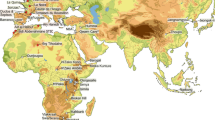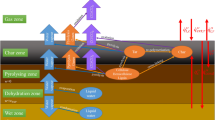Abstract
Heat treatment of silcretes in the Middle Stone Age of southern Africa has been taken to indicate complex behaviour among early modern humans. This inference is based on the apparent sensitivity of silcretes to rapid changes in temperature, requiring well-regulated heating and cooling rates, and controls over maximum heating temperatures. Alternative arguments have been made that silcrete can effectively be heat treated with limited control over heating rates such that heat treatment may have been a relatively simple process. These apparently contrasting points of view elide the fact that different silcretes may respond differently to heating, and that no single approach may be appropriate in all cases. To test this proposition, we undertook a series of controlled experiments in which silcrete from two sources on the south coast of Australia were prepared into blocks of specific sizes and heated rapidly to a range of maximum temperatures in a muffle furnace. In addition to potential differences in response between sources to heat, our experiments test two factors—stone volume and maximum heating temperature—that were advanced by past explanatory models to account for the probability of sample failure (fracture) during heating. The results of our experiments suggest that the tolerance of silcretes to high heating rates is highly variable between sources within regions, and that the effect of variation between sources is stronger than the other factors examined. Additional tests on limited samples from sources in South Africa support the general relevance of our findings. From these results, we infer that optimal approaches to heating in the past were probably sensitive to the silcretes being heated.





Similar content being viewed by others
References
Agresti A (2007) An introduction to categorical data analysis, 2nd edn. John Wiley & Sons Inc, Hoboken
Barr DJ, Levy R, Scheepers C, Tily HJ (2013) Random effects structure for confirmatory hypothesis testing: keep it maximal. J Mem Lang 68:255–278
Brown KS, Marean CW, Herries AIR, Jacobs Z, Tribolo C, Braun D, Roberts DL, Meyer MC, Bernatchez J (2009) Fire as an engineering tool of early modern humans. Science 325:859–862
Byers DA, Picka C, Ray JH (2014) Heat treatment, Ozarks cherts, and prehistoric toolstone use in Southwest Missouri. Am Antiq 79:507–521
Calender JH (1978) A study of silcretes near Marulan and Milton, New South Wales. In: Langford-Smith T (ed) Silcrete in Australia. University of New England, Armidale, pp 209–222
Christensen RHB (2015a) Analysis of ordinal data with cumulative link models—estimation with the R-package ordinal. https://cran.r-project.org/web/packages/ordinal/vignettes/clm_intro.pdf
Christensen RHB (2015b) Ordinal-regression models for ordinal data. R package version 2015.6–28. http://www.cran.r-project.org/package=ordinal/
Crabtree DE, Butler BR (1964) Notes on experiments in flintknapping 1: heat treatment of silica minerals. Tebiwa 7:1–6
Delagnes A, Schmidt P, Douze K, Wurz S, Bellot-Gurlet L, Conard NJ, Nickel KG, van Niekerk KL, Henshilwood CS (2016) Early evidence for the extensive heat treatment of silcrete in the Howiesons Poort at Klipdrift Shelter (Layer PBD, 65 ka), South Africa. PLoS One 11:e0163874
Hanckel M (1985) Hot rocks: heat treatment at Burrill Lake and Currarong. Archaeol Ocean 20:98–103
Hothorn T, Hornik K, van de Wiel MA, Zeileis A (2008) Implementing a class of permutation tests: the coin package. J Stat Softw 28:1–23
Hughes PJ, Sullivan ME, Lampert RJ (1973) The use of silcrete by aborigines in southern coastal NSW. Archaeol Ocean 8:220–225
Kenna LS (2016) Understanding intra-source and inter-source variation on the success of silcrete heat treatment. Unpublished BA Honours thesis. School of Earth and Environmental Sciences, University of Wollongong
Mandeville MD, Flenniken JJ (1974) A comparison of the flaking qualities of Nehawka Chert before and after thermal pretreatment. Plains Anthropol 19:146–148
Marwick B (2017) Computational reproducibility in archaeological research: basic principles and a case study of their implementation. J Archaeol Method Theory 24:424–450
Mercieca A, Hiscock P (2008) Experimental insights into alternative strategies of lithic heat treatment. J Archaeol Sci 35:2634–2639
R Core Team (2017) R: a language and environment for statistical computing. R Foundation for Statistical Computing, Vienna https://www.R-project.org/
Roberts DL (2003) Age, genesis and significance of South African coastal belt silcretes, vol 95. Council for Geoscience, South Africa
Schmidt P (2014) What causes failure (overheating) during lithic heat treatment? Archaeol Anthropol Sci 6:107–112
Schmidt P (2016) The ‘sand-bath’ and lithic heat treatment in the South African Middle Stone Age: myth or reality? Afr Archaeol Rev 33:99–105
Schmidt P, Mackay A (2016) Why was silcrete heat-treated in the Middle Stone Age? An early transformative technology in the context of raw material use at Mertenhof Rock Shelter, South Africa. PLoS One 11:e0149243
Schmidt P, Porraz G, Slodczyk A, Bellot-Gurlet L, Archer W, Miller CE (2013) Heat treatment in the South African Middle Stone Age: temperature induced transformations of silcrete and their technological implications. J Archaeol Sci 40:3519–3531
Schmidt P, Porraz G, Bellot-Gurlet L, February E, Ligouis B, Paris C, Texier P, Parkington JE, Miller CE, Nickel KG, Conard NJ (2015) A previously undescribed organic residue sheds light on heat treatment in the Middle Stone Age. J Hum Evol 85:22–34
Schmidt P, February E, Bretzke K, Bellot-Gurlet L (2017a) Tempering-residue on heat-treated silcrete: an experimental perspective and a potential analytical protocol. J Archaeol Sci Rep 15:611–619
Schmidt P, Lauer C, Buck G, Miller CE, Nickel KG (2017b) Detailed near-infrared study of the ‘water’-related transformations in silcrete upon heat treatment. Phys Chem of Miner 44:21–31
Schmidt P, Nash DJ, Coulson S, Göden MB, Awcock GJ (2017c) Heat treatment as a universal technical solution for silcrete use? A comparison between silcrete from the Western Cape (South Africa) and the Kalahari (Botswana). PLoS One 12:e0181586
Steele TE, Mackay A, Fitzsimmons KE, Igreja M, Marwick B, Orton J, Schwortz S, Stahlschmidt MC (2016) Varsche Rivier 003: a Middle and Later Stone Age site with Still Bay and Howiesons Poort assemblages in southern Namaqualand, South Africa. PaleoAnthropol 2016:100–163
Summerfield MA (1981) The nature and occurrence of silcrete, southern Cape Province, South Africa. Oxford University School of Geography Research Papers, Oxford, p 28
Villa P, Roebroeks W (2014) Neandertal demise: an archaeological analysis of the modern human superiority complex. PLoS One 9:e96424
Wadley L, Prinsloo LC (2014) Experimental heat treatment of silcrete implies analogical reasoning in the Middle Stone Age. J Hum Evol 70:49–60
Wickham H (2007) Reshaping data with the reshape package. J Stat Softw 21:1–20
Wickham H (2009) ggplot2: elegant graphics for data analysis. Springer-Verlag, New York
Wickham H (2017) scales: Scale functions for visualization. R package version 05.0. https://CRAN.R-project.org/package=scales
Young RW, McDougall I (1982) Basalts and silcretes on the coast near Ulladulla, southern New South Wales. J Geol Soc of Aust 29:425–430
Acknowledgements
We thank Prof. Teresa E. Steele for enabling this research at Varsche Rivier 003, and Jacob Noblett for helping collect silcretes in NSW.
Funding
AM’s research was funded by an Australian Research Council DECRA grant (DE130100068). Identification of sources around Varsche Rivier 003 and our campfire experiments occurred during the project ‘Varsche Rivier 003: A new Middle Stone Age site (Namaqualand, South Africa)’ funded by a National Research Foundation grant (Award #1324719) to Teresa E. Steele. AFB was funded by the Tessa and Mortimer Wheeler Travel Award.
Author information
Authors and Affiliations
Corresponding author
Additional information
This article is part of the Topical Collection on Controlled experiments in lithic technology and function
Electronic supplementary material
ESM 1
(7Z 5 kb)
Appendix: Proportional odds model for BNS samples only
Appendix: Proportional odds model for BNS samples only
Rights and permissions
About this article
Cite this article
Mackay, A., Lin, S.C., Kenna, L.S. et al. Variance in the response of silcrete to rapid heating complicates assumptions about past heat treatment methods. Archaeol Anthropol Sci 11, 5909–5920 (2019). https://doi.org/10.1007/s12520-018-0663-1
Received:
Accepted:
Published:
Issue Date:
DOI: https://doi.org/10.1007/s12520-018-0663-1




